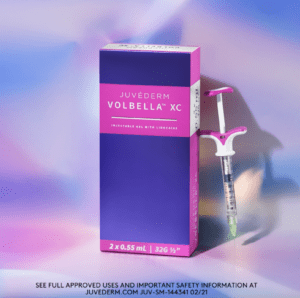
Although it has become popular in recent years, tear trough (i.e. under-eye) filler was previously considered an “off-label” treatment. “While physicians are allowed to inject fillers into this area, the procedure was not officially FDA-approved and therefore not explicitly promoted in medical practices,” explains Dr. Jennifer Vickers, a board-certified physician that practices at the Bee Cave and Central Austin locations of Sanova Dermatology.
However, Sanova Dermatology is excited to share that Juvederm Volbella is now FDA-approved to treat the infraorbital (undereye) hollows in adults over 21. This news may interest those who wish to pursue non-invasive treatments for undereye hollowing.
What is Undereye Hollowing, aka Sunken Eyes?
The tear troughs, or under-eye area, refers to the area directly beneath your lower eyelids. The appearance of sunken eyes in this area can be related to genes, health, or age.
What Causes Undereye hollowing?
There are several common causes of undereye hollowing.
Aging: As skin ages, it loses elasticity and volume. Likewise, the fat pads beneath the eyes begin to shrink.
Genetics: People with certain genetic traits may be more susceptible to eyes that appear sunken or dark.
Lifestyle: Smoking and drinking alcohol can cause increased loss of collagen and contribute to lack of sleep, both factors that can worsen undereye hollowing.
Lack of Sleep: Lack of rest can cause the body to produce excess cortisol, which breaks down collagen in the body.
Dehydration: Undereye hollows can result from a lack of water and nutrients, which causes dryness and a loss of elasticity in the skin.
Allergies: Allergies may cause inflammation and darkening around the eyes, which gives the appearance of volume loss and fatigue.
What Treatments are Available for Sunken Eyes?
“The skin near the eyes is more delicate than the skin on other parts of the face, causing vasculature under the eyes to be more visible and the skin to be laxer, both of which cause a tired appearance,” shares Dr. Vickers.
As stated, undereye hollows can result from aging, lifestyle, and medical reasons. Treatments will vary depending on the cause.
Non-Invasive medical treatments that are available for under-eye hollowing are:
- Hyaluronic acid fillers are injected directly into the skin. Depending on the filler used, they can last from six months to two years. Examples of hyaluronic acid fillers include the recently FDA-approved Juvederm Volbella.
- Laser treatments are non-invasive and use light energy to stimulate collagen production. They have a high success rate, with few side effects, and can be used alone or in conjunction with other treatments.
Cosmetic surgery offers several options:
- Blepharoplasty offers long-lasting results by removing excess skin and herniated fat around the eyes, reducing undereye bags, lax skin, and fine lines and wrinkles.
- Transcutaneous suction lipectomy involves the insertion of a cannula through an incision under the eye. A vacuum applied to the cannula draws out any herniated fat (bags) within this hollow, creating a more youthful appearance.
- Fat grafting is a cosmetic surgical procedure in which fat transfers from an area of your body – usually the abdomen – and is injected into the face to augment or reshape it. This treatment is long-lasting and is considered permanent due to its ability to integrate with surrounding tissue after healing is complete.
Various cosmetic procedures can help with undereye hollows. And, let’s face it: some produce better results than others. “The issue with many cosmetic procedures is that they can be expensive, invasive, and require extended recovery time,” shares Dr. Vickers.
One popular alternative to surgical procedures is hyaluronic acid fillers, better known as undereye fillers. Hyaluronic acid—a ground substance that exists naturally in your connective tissue —is used as a filler in cosmetic surgery, making it a safe treatment. The best part about eye fillers is that they’re non-surgical and don’t require recovery time. They’re also significantly cheaper than surgical options.
“As a result, they’re popular among people who want to get rid of hollows under the eyes or plump up the skin in other facial areas that have lost volume over time,” Dr. Vickers notes.
Undereye filler is an excellent treatment for those looking for immediate, noticeable results.
A Few Benefits of Undereye Fillers
- Quick results: Undereye filler is effective immediately and gives clients a fast and simple way to erase the signs of fatigue.
- Bright under eyes: Undereye filler can mask darkening that occurs due to thin skin and increased visibility of the vessels underneath
- Plumper under eyes: Undereye filler fills in sunken areas that cause the tear troughs to look hollow and tired. This plumping effect keeps the skin looking youthful.
- Less tired-looking under-eye: The depth of the well beneath your eye will be changed immediately, making you look younger and less fatigued.
What to Expect During an Eye-Filler Treatment
During your talk, your doctor will assess the causes of your dark circles and determine whether you are a good candidate for treatments such as fillers.
For an undereye filler treatment, you’ll want to arrive at your appointment with clean skin and makeup-free. You can apply a non-oily moisturizer before you go if you want, but this isn’t a necessity.
“Your doctor will choose a filler for your undereye area based on the amount of volume you need and the thickness of your skin,” encourages Dr. Vickers. Hyaluronic acid fillers (Juvederm Volbella) are best for thin skin, while Restylane is better for people with thick skin.
If you ask for numbing agents like lidocaine or Articaine, you will have to wait 30 to 40 minutes for the numbing medication to take effect. Without these agents, the entire procedure would take about 20 minutes.
There are two main approaches to undereye fillers: using a cannula or using a needle on its own. Your board-certified dermatologist will assess your individual facial anatomy to determine what is the best method for treatment.
Side Effects of Undereye Fillers
Bruising and swelling are possible after an undereye filler treatment. If you know you bruise easily, let your provider know before your appointment. It’s not unusual for bruising to last for a few days after the procedure.
Despite their safety, there have been complications following undereye filler treatments. Most of these reports involve improper administration techniques, but some have resulted from faulty products themselves.
The most severe complication occurs when the substance seeps into the surrounding tissues and causes blockage of blood vessels, leading to scarring and even blindness.
There are ways you can lower their risk of side effects.
- It would always be best to choose a board-certified dermatologist or plastic surgeon with extensive experience with fillers. You want someone who has comprehensive knowledge of vascular anatomy and can inject strategically so as not to cause damage to underlying blood vessels or nerves.
- Ask about the ingredients in the filler formula. The wrong mixture can cause swelling or irritation that will reduce the effectiveness of your treatment.
- Never buy online injectables and try to do this yourself—you may not know what you’re getting, and even if you get what you ordered, it could be damaged or improperly stored by a third party before you receive it.
JUVÉDERM® VOLBELLA® XC
 The FDA recently cleared a new treatment for under-eye circles. JUVÉDERM® VOLBELLA® XC is the first filler approved by the FDA to correct infraorbital (under-eye) hollows in adults over 21.
The FDA recently cleared a new treatment for under-eye circles. JUVÉDERM® VOLBELLA® XC is the first filler approved by the FDA to correct infraorbital (under-eye) hollows in adults over 21.
Until now, there were very few options to treat these areas that had FDA approval. Hyaluronic acid fillers are popular among patients for their natural-looking and immediate results. People who have undereye hollowing may benefit from these fillers because of their ability to add volume to the skin.
The newest version of JUVÉDERM® VOLBELLA® XC contains a modified form of HA that lasts longer and works faster than other treatments on the market.
Note: Because of the nature of the infraorbital hollows area, Allergan Aesthetics, in conjunction with the FDA, has determined that there should be a baseline of understanding before injecting this area. Allergan Aesthetics will provide a comprehensive training program detailing the anatomy and safety protocol when injecting in this area.
—-
While Juvederm Volbella is not the only option for undereye fillers, its FDA approval is undoubtedly an exciting breakthrough in this field of cosmetic medicine.
Sanova Dermatology finds JUVÉDERM® VOLBELLA® XC to be a safe and effective treatment for addressing moderate to severe undereye hollows. As a result, we will be incorporating this treatment into our general practice moving forward.
For more information about the benefits of VOLBELLA® XC, contact us with any questions you have.
About The Author
 Dr. Vickers is a board-certified dermatologist specializing in the evaluation and management of conditions of the skin, hair, and nails. She sees every patient as an opportunity to improve a life, whether she is treating a baby with a rash, providing a skin screening for skin cancer, or performing a cosmetic procedure. In every aspect of her practice, she strives to ensure that her patients feel comfortable, in good care, and that they are an integral part of their own health.
Dr. Vickers is a board-certified dermatologist specializing in the evaluation and management of conditions of the skin, hair, and nails. She sees every patient as an opportunity to improve a life, whether she is treating a baby with a rash, providing a skin screening for skin cancer, or performing a cosmetic procedure. In every aspect of her practice, she strives to ensure that her patients feel comfortable, in good care, and that they are an integral part of their own health.

